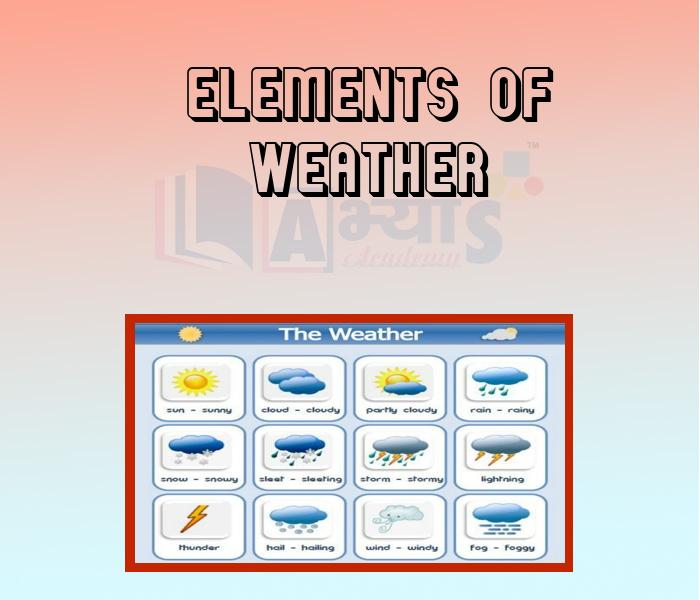Elements Of Weather












Elements Of Weather
Elements of Weather:
Temperature: Temperatures vary greatly throughout the world; this is because of the unequal amount of heat received from the sun on the earth's surface and because of the movements of air in currents caused by this unequal heating. Areas near the equator receive the largest amount of heat annually and Polar Regions receive the least of that. Temperature is also determined by cloud cove, winds, altitude, season, time of day, and the heating or cooling influences of large land masses, lakes, and oceans.
Pressure: Pressure is another weather element that usually cannot be felt but must be measured with an instrument. Pressure varies on the earth's surface because of the varying weight of the atmosphere, causes mainly by the atmosphere's almost constant movement. Changes in the heating, and cooling of land and water masses can cause air pressure to change. This change in air pressure creates winds, as air tends to move in a deflected path from an area of high pressure to one of low pressure. Low pressure areas have less atmospheric mass above their location, whereas high pressure areas have more atmospheric massabout their location. Pressure decreases rapidly with altitude.
Moisture: Humidity is the measure of the water vapour content in the air; combined with the temperature it causes many weather conditions. The amount of vapour in a given volume of air at a given time is called the absolute humidity. While relative humidity is the amount of water vapour that exists in a gaseous mixture of air and water, hot and cold weather are more comfortable when the relative humidity is low. Clouds are formed when water vapour condenses high above the ground. When cloud droplets grow larger and become too heavy to be held up by the air currents, they fall to the ground in a form of rain. If the raindrops fall through a layer of air which is below freezing, the drops freeze and fall in a form of snow.
Precipitation: The mechanism of transferring moisture from the atmosphere to the surface of the earth is called precipitation. The vanious forms of precipitation include fog and dew, which occur when moisture in air, just above the ground level, transforIns from vapour to liquid form. Other forms of precipitation like rain, hail and snowfall occur as the result of the cooling of a mass of warm, moist air. The process of cooling of the air is set off by the rising of the warm, moist air. As the air rises, it expands because atmospheric pressure decreases at higher attitudes. When the air expands, it causes the rising air to become cooler.
The Amount of water vapour present in the atmosphere is known as ________ . | |||
| Right Option : B | |||
| View Explanation | |||
Students / Parents Reviews [10]
About Abhyas metholodology the teachers are very nice and hardworking toward students.The Centre Head Mrs Anu Sethi is also a brilliant teacher.Abhyas has taught me how to overcome problems and has always taken my doubts and suppoeted me.

Shreya Shrivastava
8thBeing a parent, I saw my daughter improvement in her studies by seeing a good result in all day to day compititive exam TMO, NSO, IEO etc and as well as studies. I have got a fruitful result from my daughter.

Prisha Gupta
8thA marvelous experience with Abhyas. I am glad to share that my ward has achieved more than enough at the Ambala ABHYAS centre. Years have passed on and more and more he has gained. May the centre flourish and develop day by day by the grace of God.

Archit Segal
7thIt was a good experience with Abhyas Academy. I even faced problems in starting but slowly and steadily overcomed. Especially reasoning classes helped me a lot.

Cheshta
10thIt was good as the experience because as we had come here we had been improved in a such envirnment created here.Extra is taught which is beneficial for future.

Eshan Arora
8thIt has a great methodology. Students here can get analysis to their test quickly.We can learn easily through PPTs and the testing methods are good. We know that where we have to practice

Barkha Arora
10thI have spent a wonderful time in Abhyas academy. It has made my reasoning more apt, English more stronger and Maths an interesting subject for me. It has given me a habbit of self studying

Yatharthi Sharma
10thMy experience was very good with Abhyas academy. I am studying here from 6th class and I am satisfied by its results in my life. I improved a lot here ahead of school syllabus.

Ayan Ghosh
8thAbhyas is a complete education Institute. Here extreme care is taken by teacher with the help of regular exam. Extra classes also conducted by the institute, if the student is weak.

Om Umang
10thMy experience with Abhyas academy is very good. I did not think that my every subject coming here will be so strong. The main thing is that the online tests had made me learn here more things.
